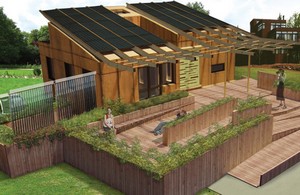 Third time is the charm, at least for building Lawrence Technological University's solar house. The small-yet-energy-positive home that competed in the Solar Decathlon will be built for the third and hopefully final time in Troy starting today.
Third time is the charm, at least for building Lawrence Technological University's solar house. The small-yet-energy-positive home that competed in the Solar Decathlon will be built for the third and hopefully final time in Troy starting today.
The house, a gift from the Troy Chamber of Commerce to the city, will be rebuilt at the city of Troy's Community Center on Big Beaver Road near I-75. There it will be used as a center for recreation activities and an educational tool on available environmentally friendly building techniques and technologies.
Construction crews will assemble most of it this fall, seal it for the winter and then finish things off in the spring when the harsh weather relents. Doing so will be old hat for the team that created it. They have already assembled and disassembled the "green" domicile at Lawrence Tech's Southfield campus and again at the decathlon in Washington, D.C. earlier this year.
"It's even more satisfying seeing it go up in Troy than it was in D.C.," says Philip Plowright, a faculty advisor on the project and an associate professor of architectural theory and design at Lawrence Tech. "We're quite happy with it."
A team of more than 40 Lawrence Tech students called ALOeTERRA (which means "to nourish the earth") designed and built the house over the summer. Volunteers from the Michigan Regional Council of Carpenters and Millrights also lent a hand creating a home that harnesses the sunlight into enough electricity to power the home's utilities (along with some left over for a small electric vehicle).
Team ALOeTERRA purposely used green building techniques and technologies widely available to the public so the house can serve as a showcase on how regular people can conserve energy in housing.
For instance, the primary source of energy for hot water and heating is an array of evacuated tubes. The system can store a day's worth of hot water and pay for itself in energy savings in about two years. All of the home’s electricity is generated by photovoltaic solar panels that cover much of the roof. When sunlight isn’t available, the home’s battery system will meet all the energy needs for things like heating, ventilation and air conditioning. To make the house energy positive, meaning it produces more energy than it consumes, Team ALOeTERRA utilized a number of energy conservation ideas to control the home's energy appetite.
"It's a 10," Plowright says. "It's completely off the grid."
The house was Lawrence Tech's entry into the Solar Decathlon in Washington, D.C. It was part of a "solar village" exhibition on the National Mall where more than 100,000 visitors toured it earlier this fall. It also competed against a field of 20 universities – including MIT, Carnegie Mellon and Cornell – in this year's decathlon, a prestigious international competition where universities contend to build the most attractive and energy-efficient, solar-powered home.
Lawrence Tech was the smallest college in the contest and the only one from Michigan. Its house was one of the runners-up in the BP People’s Choice Award competition, thanks to an architectural design many found attractive and livable.
Source: Eric Pope, spokesman for Lawrence Tech and Philip Plowright, associate professor of architectural theory and design at Lawrence Tech
Writer: Jon Zemke
Enjoy this story?
Sign up for free solutions-based reporting in your inbox each week.